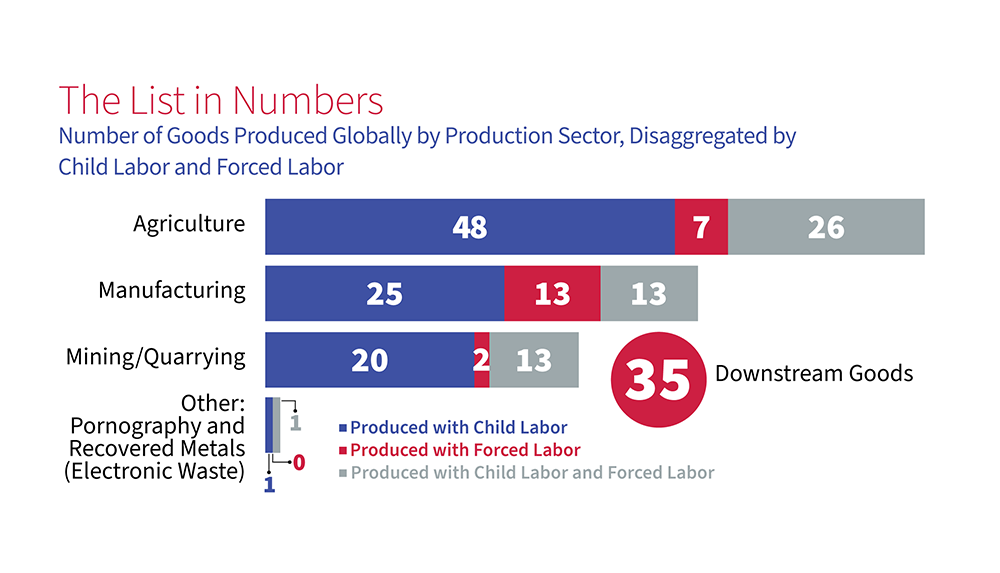List of Goods Produced by Child Labor or Forced Labor
The Bureau of International Labor Affairs (ILAB) maintains a list of goods and their source countries which it has reason to believe are produced by child labor or forced labor in violation of international standards, as required under the Trafficking Victims Protection Reauthorization Act (TVPRA) of 2005 and subsequent reauthorizations. The List of Goods Produced by Child Labor or Forced Labor comprises 204 goods from 82 countries and areas, as of September 5, 2024.
ILAB maintains the List primarily to raise public awareness about forced labor and child labor around the world and to promote efforts to combat them; it is not intended to be punitive, but rather to serve as a catalyst for more strategic and focused coordination and collaboration among those working to address these problems.
Publication of the List has resulted in new opportunities for ILAB to engage with foreign governments to combat forced labor and child labor. It is also a valuable resource for researchers, advocacy organizations and companies wishing to carry out risk assessments and engage in due diligence on labor rights in their supply chains.
The countries on the List span every region of the world. The most common agricultural goods listed are sugarcane, cotton, coffee, tobacco, cattle, rice, and fish. In the manufacturing sector, bricks, garments, textiles, footwear, carpets, and fireworks appear most frequently. In mined or quarried goods, gold, coal and diamonds are most common.
ILAB published the initial TVPRA List in 2009 and updated it annually through 2014, following a set of procedural guidelines that were the product of an intensive public consultation process. ILAB now updates and publishes the List every other year, pursuant to changes in the law.
Procedural Guidelines
On January 25, 2024, ILAB's Office of Child Labor, Forced Labor, and Human Trafficking published Procedural Guidelines for the development and maintenance of the List of Goods from countries produced by child labor or forced labor in violation of international standards.
DOL's mission is to foster, promote, and develop the welfare of the wage earners, job seekers, and retirees of the United States. This DOL mission is carried out by a variety of sub-agencies and offices (DOL agencies) covering domestic and international policy engagements, workforce development, enforcement, statistics, and benefits. DOL has a responsibility to protect the integrity of scientific information that is produced, communicated, and used across DOL agencies to better carry out its mission. ILAB is committed to using the highest possible scientific integrity and quality standards and practices to conduct our critical work. Scientific integrity is the adherence to professional practices, ethical behavior, and the principles of honesty and objectivity when conducting, managing, using the results of, and communicating about science and scientific activities. Inclusivity, transparency, and protection from inappropriate influence are hallmarks of scientific integrity.
| Country/Area Sort descending | Good | Exploitation Type |
|---|---|---|
| Paraguay | There is evidence that children ages 5 to 17 raise cattle in Paraguay. National legislation designates cattle raising as a hazardous activity prohibited for children in Paraguay. In 2016, the Government of Paraguay published representative results from the Survey of Activities of Rural Area Children and Adolescents 2015. The survey considers a working child to be engaged in child labor if the child is below the minimum age for employment of 14 or the child is performing work that is hazardous according to national legislation. The survey estimates that 301,827 children ages 5 to 17 perform hazardous work in rural areas of Paraguay and indicates that children working in agriculture experience accidents and illnesses, including from using dangerous tools and handling chemicals. According to the survey, almost 13 percent of Paraguayan children engaged in child labor in agriculture do not attend school. The survey estimates that 142,127 child laborers raise cattle throughout rural areas in Paraguay. Approximately 67,141 child laborers raising cattle are below the minimum age for employment in Paraguay. The survey indicates that more boys than girls are engaged in child labor in cattle raising. The release of this survey demonstrates the Government of Paraguay’s commitment to addressing child labor and its acknowledgement that data collection is vital to the design and implementation of sound policies and programs. |
Child Labor, Forced Labor |
| South Sudan | There are reports that children, especially boys, are abducted and forced to herd cattle in South Sudan. Hundreds of abductions have been reported, particularly in communities in Jonglei and Eastern Equatoria states. The children are abducted when rival tribes or ethnic groups enter communities to steal cattle, as well as during other inter-ethnic or inter-tribal disputes; some of these children are enslaved to herd cattle. |
Child Labor, Forced Labor |
| Tanzania | There is evidence that children under the age of 18 raise cattle in Tanzania. Based on an analysis of the Tanzania Integrated Labour Force Survey 2020/21, it is estimated that 347,957 child laborers raise cattle. Children who work with livestock may be at risk of exposure to hazards including working long hours, being injured by the animals, and exposure to the elements, diseases, and chemicals such as disinfectants. The Government of Tanzania should be commended for conducting and publishing survey data that help to design and implement sound policies and programs to address child labor. |
Child Labor |
| Uganda | Child Labor | |
| Zambia | Child Labor |
your hand? Download ILAB's Sweat & Toil App today!
Are you a company looking to fight child labor and forced labor in supply
chains?


